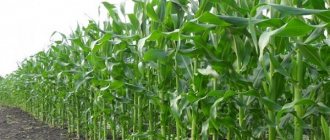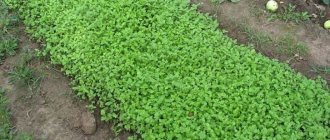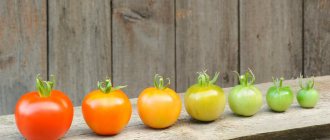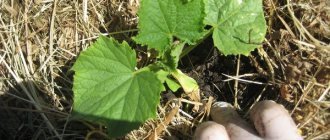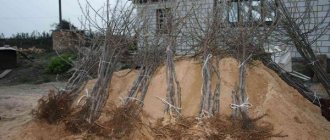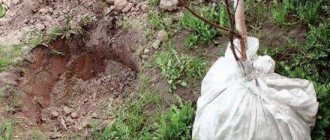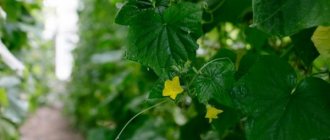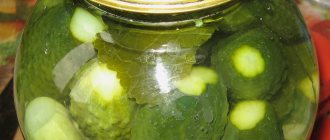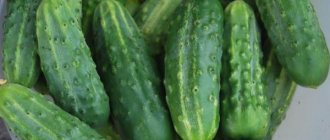How to choose a variety for growing cucumbers in open ground?
Choosing a variety is not so easy. Today there are a huge number of them, and they all have different characteristics.
What to look for when choosing a cucumber variety:
- Varieties with different ripening periods. It is better to grow several types of vegetables in open ground. Some should bear fruit at the beginning of summer, others in the middle, and others at the end. This is convenient since you will be picking cucumbers throughout the summer season.
- Self-pollination. It is better to choose plants that do not require additional pollination. Self-pollinating varieties are described in this article.
- Cold resistance and shade tolerance of the variety. No one can predict exactly what the weather will be like throughout the summer, so choose those varieties that can survive any precipitation and climate changes.
- Salad or pickling. The main task here is to decide on the purpose of cultivation. Some varieties are suitable only for pickling, others are excellent fresh, but are not suitable for preservation. Pay attention to this, or better yet, plant several varieties of cucumbers.
- Branching. Excessive branching causes a lot of concern when caring for a crop. A large amount of greenery takes away the strength of the plant, and fruiting decreases as a result. Therefore, it is better to choose varieties characterized by a compact bush.
Types and varieties
According to their intended purpose, cucumber varieties are divided into salad, canning and universal. Canned cucumbers have thin skin and have a high sugar content, which is very important when pickling and canning. The rougher and thicker skin of salad varieties prevents the brine and marinade from penetrating into the vegetable, but these cucumbers are much tastier fresh than canned greens. Versatile cucumbers can be canned or eaten fresh.
Canned cucumbers include the following varieties: Business, Brigantina, Rodnichok, Favorit, Voronezhsky, Zasolochny, Urozhayny 86, Nadezhny, Nezhinsky local, Competitor, Cascade.
Salad varieties: Adam, Graceful, Movir, Saltan, Phoenix, Parade, Synthesis, Rzhavsky local.
Universal varieties of cucumbers: Stork, Epilogue, Marinda, Regia, Duet, Cruise, Crane, Farmer, Sagittarius, Moravian gherkin, Khabar and others.
According to the ripening period, cucumbers are divided into early-ripening varieties, which ripen in 32-45 days, mid-ripening varieties, which require 40 to 45 days for full maturity, and late-ripening varieties, which ripen up to 50 days or longer.
Early varieties and hybrids include: Liliput, Graceful, Zabiyaka, Emelya, Zadavaka, Vyuga.
Medium-ripe varieties of cucumbers: Picas, Atlet, Stepnoy, Solnechny, Unity, Dalnevostochny 27, Competitor, Topolek.
Late varieties: Nezhinsky, Phoenix, Khrust, Secret, Chinese climbing, Spring, Chinese miracle, Parisian, Mother-in-law.
Cucumbers are divided into hybrids and varieties: hybrids, when propagated by seed, do not retain their properties, like varietal cucumbers, which are capable of transmitting the characteristics of the variety through several generations. But hybrids begin to bear fruit earlier and more abundantly; in addition, they are stored longer and turn yellow much later than varietal cucumbers, so the seeds of hybrids are more valuable and an order of magnitude more expensive than the seeds of varietal cucumbers.
Hybrid varieties include: Buyan, Marinda, Othello, Parker, Regina, Pasadena, Business, Ajax, Brigantina, German, Emelya, Katyusha, Lastochka, Faithful Friends and others.
According to the type of pollination, cucumbers are divided into bee-pollinated, which are grown in open ground, and self-pollinated, or parthenocarpic, grown both in greenhouses and in the garden.
Bee-pollinated varieties of cucumbers: Atlet, Zhuravlenok, Zastolny, Izyashny, Lyubimchik, Slavyansky, Katyusha, Konkurent, Casanova, Nugget, Lastochka and others.
Self-pollinating varieties: Adam, Aelita, Stella, Yuventa, Russian style, Romance, Picnic, Navruz, Marta, Pasadena, Voyage, Danila, Amazon, White Angel and others.
Based on the size of the greens, cucumbers are divided into gherkins, the length of which is no more than 8 cm, and salad-type cucumbers, intended to be eaten raw.
Gherkin varieties include varieties of German selection: Adam, Graceful, Othello, Libelle and others.
According to the nature of the surface, cucumbers are small-tubercular and large-tubercular, and the spines on them can be white or black.
White-thorned salad varieties: Emerald Stream, Chinese Snakes, Chinese Heat-Resistant.
Black-thorn pickling varieties: Nightingale, Real Colonel, Salting, Liliput, Aquarius and others.
If you are interested in exotic varieties and hybrids, then there are many of them among cucumbers. For example:
Chinese long-fruited cucumbers
the stem of which reaches 3.5 m in length, and the fruits - from 40 to 90 cm, however, they amaze not only with their size and excellent taste, but also with their ease of cultivation, ease of care and high yield. The most common varieties: Chinese miracle, Chinese long-fruited, Chinese farmer's, Chinese white, Emerald flow, Lio Ming, Chinese disease-resistant;
Armenian cucumbers
have a very unusual appearance: ribbed fruits up to 50 cm long and weighing up to a kilogram are covered with silver-white fluff. The stems of Armenian cucumbers reach a length of 4 meters. This curiosity is grown both in open ground and in greenhouses. Varieties: Silver melon, White Bogatyr, Melon Flehu-ozus;
Italian cucumbers
They are called so because they are the result of the work of Italian breeders. Outwardly, they are similar to Armenian cucumbers - they are also ribbed. But the color of the peel, depending on the variety, can be light green, like the Waterbuzze variety, or Tortorello, whose taste simultaneously resembles both watermelon and cucumber, or dark green, which over time becomes orange-yellow, like the Barrese variety, cucumber with watermelon flavor;
Crystal Apple
English breeders managed to develop an amazing cucumber hybrid that looks more like a lemon, although it tastes like an ordinary cucumber. For some reason this miracle is called the Crystal Apple. These lemon-cucumbers, called apples, grow on a six-meter stem;
White cucumbers
Growing equally well both in greenhouses and in the garden, they form long vines and are not afraid of diseases and fifty-degree heat. The most delicate, sweetish cucumbers reach a length of 20 cm; the only drawback of white cucumbers is that they quickly outgrow. Best varieties: Italian White, Snow Leopard, Bride, Snow White, White Angel, Three White Leaves;
Mini cucumber
Or melotria roughis - a decorative perennial vine from Africa with rich green leaves that do not change color until October, and small fruits up to 2.5 cm in diameter, similar to watermelons, but the taste is like ordinary cucumbers that can be eaten fresh, or you can salt or preserve it;
Indian cucumber
Or momordica, you can easily grow it both in the garden and on the windowsill. The foliage of the plant is decorative, the bright yellow flowers smell like jasmine, and the lumpy, elongated fruits gradually change color from dark green to bright orange as they grow. When the fruit ripens, it opens up and becomes like a crocodile with its mouth open, which is why the vegetable is often called “crocodile cucumber”;
Serpentine cucumber trichosanthus
Also a pumpkin plant, widely cultivated in Southwest Asia. Trichosanth is easy to care for and immune to disease; its fruits, reaching a length of 120 cm, have a cylindrical shape, and they wriggle like snakes, changing color from green to orange as they ripen. Trichosanth flowers resemble weightless snowflakes with a diameter of 4 cm;
Red cucumber tladianta dubious
A perennial liana up to 5 m tall, native to Southeast Asia. Tladianta leaves are light green, heart-shaped, tulip-like flowers are bright yellow, the fruits are small, suitable for canning and pickling, until they grow 15 cm and begin to turn red. Overgrown and reddened fruits become sweet and make excellent jam;
Antillean cucumber Anguria
A plant with watermelon leaves, stems up to 4 meters long and small fruits weighing 30-50 g, which taste like cucumber and are suitable for pickling. Anguria is often grown as an ornamental plant.
Rules for growing cucumbers
Simply planting cucumber seeds will not be successful, since it is necessary to strictly follow the algorithm, as well as follow certain rules for sowing cucumber seeds in the ground.
Seed preparation
Almost all summer residents grow cucumbers using the seedling method, since the seeds of this crop germinate well.
Cucumber seed remains viable for 6 years, but it is better not to delay sowing and use seeds no older than 3 years for growing seedlings.
If you have used seeds since last year, you know how they germinate and how quickly. But if the seed has been purchased, it is better to process it in advance and prepare it for sowing. First, select the best specimens (large, intact, without spots), and throw away the bad ones.
In special stores they sell coated or glazed grains; they do not need any processing, since they are already fully prepared for planting. Such seeds are sown immediately dry.
After selecting the seed, carry out disinfection. Use phytosporin, dilute it strictly according to the instructions. This procedure will help get rid of harmful microflora that remains on the shell of the grains.
Many gardeners recommend using a weak solution of potassium permanganate, but some of their opponents believe that this remedy is less effective than phytosporin. Etching should be carried out for at least 20 minutes. Then rinse the beans with cold, clean water.
The best effective way to prepare seeds for planting is soaking and germination. Be sure to disinfect them first. To germinate, take cucumber grains, place them in damp gauze, place them on a plate, wrap them in a bag on top and put them in a warm place (+22...+26 degrees Celsius). Under these conditions, the seed will germinate within 2 days.
If you are a summer resident from a harsh region, then it is better to carry out additional hardening. To do this, place the sprouted seeds in the refrigerator, but not in the freezer, and keep there for 5 days. After hardening, plant the seeds in pots with substrate.
Timing for sowing seeds for seedlings
The timing of sowing directly depends on the region of germination of the crop, as well as on the place of planting: in a greenhouse or open ground. If the climate is favorable and there are no repeated frosts, plant the seeds in early March, or possibly at the end of February. But if the climate does not allow it, and summer comes late for you, then you should start growing seedlings only in April.
Planting seeds for seedlings: step-by-step diagram
The best soil for growing cucumber seedlings: peat, turf soil, sawdust and humus (all mixed in equal parts). If you don’t have the opportunity or desire to make the mixture yourself, you can purchase it at the store.
Gardeners note two options for growing seedlings:
- In the same container with future transplantation of sprouts.
- In separate glasses.
This crop does not always tolerate replanting well, so it is better to plant the plants immediately in separate cups. Regardless of the method you choose, the seeds must be placed in the grooves without deepening them; sprinkle a little soil on top. Just don't forget to moisten it beforehand. After sowing the sprouted grains, lightly water the soil again from the sprayer and place the cups (one container) in a warm place.
In order for the seeds to feel comfortable and also to germinate quickly, they must be covered with film or glass. When the sprouts appear, be sure to remove the cover. At a temperature of +20...+26 degrees Celsius, after 5-7 days the first leaves should appear. During this period, water the plants as the soil dries out.
Characteristics and features of early cucumbers
Early cucumbers are planted as seedlings : 3-4 weeks before planting in the ground, the seeds are disinfected and sown in prepared containers with soil. The seedling method increases germination, accelerates adaptation to external climatic conditions and ripening time.
Early varieties require special care - due to the short ripening period, fertilizing is applied every week. It is not recommended to overcook ripened cucumbers on the plant; the fruits will become limp and crack, and the yield will decrease.
Seedling care
If it is very cold on the windowsill or the wind is constantly blowing, then you should not place containers there. Place them in another place, and compensate for the lack of light with additional lighting.
Temperature
As soon as the cotyledons have unfolded, gradually reduce the temperature to +15...+17 degrees for 2-4 days so that the seedlings do not begin to stretch or droop. The following days the temperature is kept at +17...+19 degrees, at night it is lowered to +14 degrees.
Lighting
Cucumbers are very sensitive to the presence of light, so in cloudy weather the seedlings must be placed under a phytolamp. If plants sprout in greenhouses, then they are additionally opened so that the sun's rays fall on the sprouts as often as possible.
Watering
Cucumber seedlings will die without proper watering. The soil must be constantly moist, however, stagnation of moisture must be avoided. Add warm or room temperature water. The root system of the crop dies from cold water.
Thinning
When planting seedlings in separate pots, sow 2 grains in each. If both of them sprout, then you need to choose the strongest one and cut the second one with scissors. It is not recommended to pull out the sprout, otherwise there is a risk of damaging the root system of the healthy remaining plant.
Adding soil
Throughout the entire period of growing sprouts, you need to add soil several times as the plants grow. Just be careful not to add soil above the cotyledon leaves. This technique will help strengthen the root system of plants and ultimately increase fruiting.
Picking seedlings
If you decide to use a large box for growing seedlings, then in the phase of several leaves the sprouts should be picked, that is, transplanted into separate containers. To do this, carefully take a tablespoon, carefully lift the seedling with a lump of soil and transfer it to another container with damp soil. Then add some soil and moisten it.
This culture is very delicate and fragile, so picking is difficult. The plants also have a very spreading root system that intertwines between other plants. During transplantation, seedlings are often damaged.
It is better to immediately plant the seeds in separate cups, then you can avoid problems with picking.
Hardening off seedlings before planting
Hardening helps strengthen the plant's immunity; it should be carried out a week before transplanting cucumbers into open soil. The process involves bringing the sprouts out into the fresh air. The first time, keep it outside for about a quarter of an hour, then increase the time.
Stimulation
Cucumbers bear fruit most effectively if the daytime temperature on a sunny day is between 21–26 ˚С, and at night it becomes a little cooler, about 18–19 ˚С. But we all know how hot it can be in a greenhouse in the summer. To make the daytime environment inside more comfortable for plants, experts have long whitewashed the roof with a regular chalk solution at the height of summer. This really gives good results. In some greenhouses, it is more convenient to do without painting, but simply stretch a synthetic mesh or thin white non-woven material under the roof, securing it with clothespins or office clips to the frame elements.
If warm nights last for 2–3 weeks in a row or longer, the cucumbers will bear fruit well at first, but then become exhausted and reduce yield. In this case, a night's rest will help them: try ventilating the greenhouse late in the evening for a week so that it cools down to 16–18˚C. After this, the cucumbers will come with renewed vigor.
Organization of space. How best to plant cucumbers Read more
Transplanting seedlings into open ground
Seedlings are considered grown and ready for transplanting into open soil when they reach an age of 20-30 days and grow to a height of 0.3 m. The sprouts must be strong with a well-developed root system.
Soil selection and preparation
For good development of the plant, you need to plant the sprouts in a multi-layered warm bed. Look for a sunny and windless area. First, lay a drainage layer; you can use branches, straw or grass. Place the layer to a depth of about 0.3-0.5 m and compact it well. Place fresh manure on top.
Do not touch the bed until early spring, during which time the layers will settle a little. At the beginning of May, make a layer of fertile soil. Install the arcs and stretch the film. After a couple of days, start planting the cucumbers directly.
The manure will begin to burn out under the fertile soil, and accordingly it will release the heat that the plants of this crop need. In addition, cucumbers will receive all the nutritional elements they need. This bed is prepared in the fall, but you can make it in the spring.
Algorithm for creating a warm bed for cucumbers in the spring:
- Place a layer of manure on the drainage (in this case, you can use unrotted manure), mix it with 3 cups of wood ash and 100 g of nitrophoska (per 1 sq. m).
- Sprinkle a fertile layer of soil on top, cover with film and press down with some heavy weight.
- Do not touch the bed for at least 10 days.
- Make holes in the beds and plant seedlings.
If it is difficult to buy manure, you can make special compost. It is created in the summer: grass, weeds and leaves are collected, everything is thrown into one hole and from time to time turned over with a shovel or pitchfork. In the spring there will be ready-made garden compost.
Planting cucumbers in open ground
As soon as 2-3 true leaves appear on the seedlings, the seedlings are transplanted into warm beds. Before transplanting the plants, the soil is moistened and holes are made in it for the seedlings.
The seedling method of growing cucumbers gives good results, provided that temporary shelter is created from unexpected first frosts.
The best time to plant seedlings is the end of May.
After the threat of cold weather has passed, you can remove the shelter and start growing cucumbers on a trellis. Depending on the crop variety, keep the distance between seedlings within 0.3-0.5 m.
You can find out which varieties of cucumbers will give the best harvest in open ground here.
Watering cucumbers
The culture loves water very much, so do not allow the soil cover to dry out. Water the crop with warm, settled water; plants cannot tolerate cold water and often die from it. If the weather is not sunny, then water at any time of the day, but if it is too hot, only in the evening.
For 1 sq. m – 6-12 liters of water.
Experienced gardeners believe that plants grow better if they are sprayed from a watering can, thus increasing air humidity. After adding water, loosen the soil, just do it very carefully so that the root system of the cucumbers is not damaged. Thanks to this procedure, cucumbers receive more air, moisture evaporation is also reduced, and accordingly photosynthesis will begin to occur according to all the rules.
Feeding cucumbers
The best fertilizer for crops is manure. For 1 sq. m – 5 kg of product. Mineral fertilizers also bring excellent results, but they should be applied carefully, because cucumbers are very sensitive to changes in the soil, and an excess of any elements does not have a very good effect on the crop. For 1 sq. m take urea (10 g) + superphosphate (25 g) + potassium sulfate (15 g).
Apply fertilizing with phosphorus and potassium in the fall, and with nitrogen before sowing plants.
Potash fertilizers are no less useful; the best remedy is wood ash (100 g per 1 sq. m). It is unique in that it does not contain chlorine, which cucumbers do not like. Wood ash also reduces soil acidity. In addition, ash has been known for many years, so its effectiveness is time-tested.
Hilling
Hilling is also useful for cucumbers; it should be done 2 times per season. This action will help plants grow roots and protect sprouts from various fungal diseases.
Formation of bushes
The formation of the crown is necessary in order to stimulate the growth of side shoots on which female flowers will appear. The process is carried out by pinching the central shoot above the 6th leaf. Please note that early ripening varieties are not formed; the procedure is necessary for late and mid-ripening plants.
Harvesting
These vegetables are not stored for long, so their seeds cannot boast of long-term storage. Thick-skinned varieties last longer than others. After collecting vegetables from the garden, put them in the refrigerator or other dark and cold place. If kept warm, they will lose their beneficial properties and excellent characteristic taste within 24 hours.
Botanical description
The stem of the cucumber is rough, creeping, reaching two meters in length and ending with tendrils with which the plant clings to the support. The leaves are five-lobed, heart-shaped. The fruit is emerald green, bubbly, juicy, multi-seeded, with a structure characteristic of Cucurbitaceae. The shape and size of the fruit varies depending on the variety.
Despite the fact that cucumber is 95% water, it contains useful microelements - iron, magnesium, phosphorus and calcium and vitamins - C, B1, B2, provitamin A. Cucumber juice is a structured liquid that perfectly removes waste and toxins and is beneficial affecting the state of the human body. Cucumbers are a source of iodine in compounds that are easily absorbed.
How to increase the yield?
Gardeners have long understood that high-quality care and formation of bushes are not all the requirements and ways to increase the yield of cucumbers. There are other options for the formation of a huge number of female flowers.
Advice from experienced summer residents:
- Stop watering before flowering begins. This method stimulates the plants and gives them time to “think” that they are dying. In a stressful situation, cucumbers begin to form ovaries faster.
- Growing several varieties in one area. The best option for increasing fruiting is cross-pollination.
- Girding of stems. Make a small cut under the first pair of leaves. Carry out this activity only in dry weather. Banding will complicate the outflow of nutrients to the root system and will help the plant form as many ovaries as possible.
- Foliar feeding during the season of green foliage formation. Use urea (20 g of product per 10 liters of water).
- Removal of the first ovary. This method strengthens the roots and gives the plants the strength to form ovaries.
- Attracting bees to the site. They will improve pollination. You can also plant honey plants.
- Vertical position of the plant. It's all about the supports, they are different, but it is better to use vertical ones so that the cucumbers feel comfortable on them, the fruits will be ventilated, harvesting will become easier, and the plant will begin to bear fruit better.
How to get a rich harvest of cucumbers in open ground? How to grow cucumber seedlings? How to feed cucumbers? You will learn all this if you watch the video to the end:
Extension
Over time, even the most well-groomed cucumbers get tired and stop producing new fruits. To rejuvenate plants tied vertically in a greenhouse, you need to lower the ropes holding them so that the lower part of the stem without leaves, 25–40 cm long, lies on the ground. Cover it with a layer (5–7 cm) of fertile soil or rotted compost and water with warm water. As a result, new adventitious roots are formed and growth is activated. Plants will become more resistant to root rot. If the plantings in the greenhouse are thickened, you need to remove old, pale leaves and shorten the side shoots to three leaves.
Advice from Alexey Portyankin and Lyubov Chistyakova was used
Caring for cucumbers during fruiting
As soon as the plants begin to bear fruit, they collect all the useful components from the soil. Their absence leads to poor yields. During this period, seedlings should be fertilized with potassium, nitrogen and magnesium.
Fertilizers are applied twice:
- At the beginning, when it is necessary to increase the quantity of the crop and its quality. Mix potassium sulfur (30 g) + water (10 l) or dissolve 1 tbsp. l. nitrophoska in 5 liters of water. It is better to carry out the procedures on a cloudy day. To enhance the effect, apply fertilizer to moist soil. You can also use wood ash (1 cup per 5 liters of water).
- At the end, when you want to extend the fruiting period. Mix urea (15 g) and water (10 l). A stimulator for re-blooming is an infusion of cut grass in a 1:1 ratio with water.
Cucumbers are a heat-loving crop; the plants will not bear fruit well without proper care. They bring good results after fertilizing, hilling, loosening and bush formation. Take care of the crop, and it will delight you with a bountiful harvest.
0
0
Copy link
Collection
Ripening fruits should be picked frequently, every 1–2 days.
At the beginning of fruiting, it is better to take them very small, so as not to overload the root system: overgrown fruits lose quality and prevent the new harvest from ripening. It is necessary to regularly collect not only good greens, but also accidentally missed ones. It is useless to leave them for seeds, since cucumbers are now mostly hybrid and even often parthenocarpic (do not form full-fledged seeds). But each seed plant deprives the gardener of 5–7 kg of greens. Damaged, deformed ovaries also need to be removed so that the plant does not waste its resources on them.
It is better to collect fruits in the first half of the day. You should act carefully, without pulling the vines and touching the fruits only when necessary (otherwise the protective waxy coating with which nature itself has carefully provided them will be erased). Cucumbers can be picked with or without stalks. Novice gardeners often leave the harvested greens in the heat for a long time, but it is better to immediately put them in a plastic bag and put them in the refrigerator - in this case, the cucumbers will remain fresh for 10 or even 20 days.
Loosening and mulching. Rules for caring for cucumbers Read more
Cucumbers on covered beds
This shelter is temporary; with the passing of frost and the onset of warm nights, the material is removed.
1 way
They lay out a bed of rotting manure, which provides warmth. To enhance heating, the bed is spilled with hot water. A depression or trench is left on top, which is filled with soil and seeds or seedlings are planted.
Cover over installed arches or frame. In case of extreme cold, cover the non-woven material with film or old fabric items.
When is the best time to pick cucumbers: morning or evening
What time of day is it best to harvest crops from the garden? At any time convenient for you. It all depends on the degree of maturity, the size of the fruit and the intended use. It is better to harvest early in the morning or late in the evening , as the cucumbers become saturated and retain a large amount of moisture, which makes them more elastic.
Important! Do not pick cucumbers with your fingers. Use pruning shears or a knife. Leave the stalks on the vines.
During harvesting, do not tug or pull the fruit or turn the leaves over . Otherwise, you will damage the plant and its roots.
After collection, the greens are placed in a cool place and covered with a cloth to protect from wind and sun.
Protection from diseases and insects
When caring for the Courage cucumber variety, disease prevention is important.
- Olive spot;
- true and downy mildew;
- cucumber mosaic virus, rot - characteristic diseases for cucumber plants.
But this particular variety is resistant to them!
On a note! Of course, Courage cucumbers can get sick, but in the last place when compared with other hybrid cucumbers.
To reduce the risk, you just need to try a little:
- Before planting plants, pour boiling water over the beds and a weak solution of potassium permanganate.
- Disinfect the seeds of Kurazh cucumbers before planting with fungicides against thrips and spider mites.
Bordeaux mixture, Bravo, Acrobat MC, Oksikhom will come to the rescue. To save yourself from powdery mildew, you need to treat with Quadris, Rizoplan, Topaz.
Interesting on the topic: How to deal with pests of seedlings: practical advice + photos
Cucumber seeds Courage f1
If the article does not convince you to buy Courage cucumber seeds, then finally we will tell you some incredible information! According to the breeders, the variety is still a bestseller!
Moreover! Courage cucumbers are bought on an industrial scale by the DUTCH! Yes, yes, those same super-specialists known for producing seeds and selling them around the world.
of Courage F1 cucumber on your plot
, it will be enough for you to eat to your heart’s content, stock your cellar, and treat your relatives and work colleagues. Don’t forget to follow all the recommendations, and the result will be stunning – hurry up and collect!
By the way, there are another 632 articles on the channel of the same name in Yandex Zen . It is with great pleasure that we invite you to visit our VKontakte group. Join and stay informed about the release of new publications on our website.
Always yours, 4 Seasons of the Gardener
Nutritional value and composition
Cucumbers are, first of all, a low-calorie product, which per 100 grams. contains no more than 15 Kcal. For this reason, the vegetable is key in many extreme weight loss programs (for weight loss in 3-5 days), and is also necessarily included in combination diets (for systematic weight loss in 1-2 months).
INTERESTING. Cucumbers are great helpers in weight loss due to the fact that they consist of 95-97% water, and also contain difficult-to-digest fiber, mainly in the peel.
In addition to fiber, cucumbers contain essential oils, organic acids, vitamins, and a rich set of minerals.
The energy composition of cucumbers is presented:
- water = 95-97%;
- carbohydrates = 2.0-2.5%;
- proteins = 0.8%;
- fat = 0.1%.
The conditions for growing cucumbers have a significant impact on the nutritional value. Thus, the richness of the mineral composition of the soil, the illumination of the site or greenhouse, and the frequency and quality of irrigation leave their mark.
Vitamin and mineral composition of fruits:
- B vitamins (B1, B2, B9 (folic acid));
- vitamin C;
- iron;
- potassium;
- manganese;
- phosphorus;
- zinc;
- iodine;
- silver;
- copper.
Like all vegetables, cucumbers are rich in micro and macroelements. However, this vegetable cannot be called a leader among all garden crops in terms of composition. The problem lies in the high water content in cucumbers. Useful minerals account for no more than 3-5% of the weight of this product.
Cucumbers Courage: description of the variety
This is a parthenocarpic, that is, a hybrid with a bunch type of fruit growth that does not require pollination. The photo of the Courage variety shows that four cucumbers grow from one bosom at once.
Productivity of cucumbers Kurazh
Usually on a pack of seeds there is the inscription 1+1 = 3. This is not just a marketing ploy. Yes, they write this way to attract the buyer’s attention. But what about the reviews of thousands of summer residents who grow Courage cucumbers in their personal gardens? And they all talk about a triple harvest!
Fantastic - with proper care and compliance with the necessary growing conditions, the yield of Kurazh cucumbers
reaches 8 kg per bush!
Looking at the photo, reading reviews about Courage cucumbers, you can find out about 6 -12 kg per square meter...
Super-early first tender cucumbers can be tasted after 45-50 days after planting. And enjoy them for a long time - until late autumn. And it is known that hybrids bear fruit for only two months. But this is not about Courage!
In summer, it is generally useful to eat as many natural vitamins as possible. And the favorite cucumber for centuries - for sure! The description of the Courage cucumber speaks of a super-healthy composition of vitamins and microelements:
- carotene;
- folic acid;
- vitamins of group A, B.
Features of the variety and taste
Reviews
summer residents say that:
- The Courage cucumber tastes sweet and aromatic.
- In appearance, the fruits are lumpy, dense, with white spines, 12-14 cm long.
- Weighing approximately 130-140 g.
- When eaten raw, they are incredibly tasty, as they are not bitter and have a thin skin.
- The picked fruits do not lose their properties for ten days.
If we take into account the yield and the absence of barren flowers, then gardeners who grow Courage f1 cucumbers will have an excellent product throughout the summer for their entire family. And in unlimited quantities.
What affects the taste of juicy crispy pulp in general? The ratio of the seed chamber to the diameter of the fruit. If you cut a Courage cucumber and look, you will see that its core is small and there are almost no seeds. This indicator is important because affects the quality of the workpieces. How often is a housewife disappointed when she opens a jar of pickled cucumbers in winter? The treat inside is either soft, not elastic, or hollow: if you bite into it, salt water will pour out and ruin your clothes.
Plus, Kurazh cucumbers have a genetically determined lack of hooked fruit, which is also pleasant and beautiful in pickles.
Cucumbers in August - problems and concerns
If cucumbers are still growing in the beds in August, then they may already be affected by various pests and diseases. Plants should be inspected and any damaged leaves removed. In this case, it is recommended to spray the leaves with fresh mullein. Dilute it with water in a ratio of 1:6. Collected diseased leaves should be taken out of the greenhouse and burned.
At the beginning of August, you need to carry out another fertilizing. For one bucket, use one liter jar of mullein, one teaspoon of urea, one tablespoon of superphosphate and one tablespoon of potash fertilizers.

